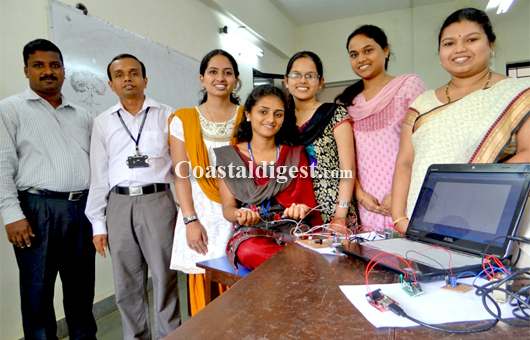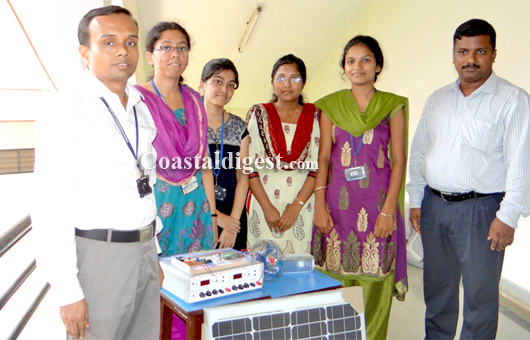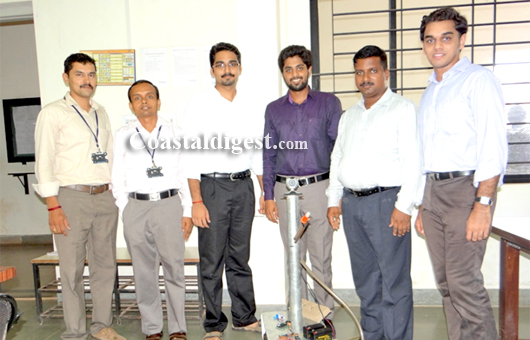Mangalore, Jun 12: Students of Electronics and Communication in the Canara Engineering College have come up with three innovative projects with the support and guidance of their professors. All three projects have immense potential for practical use.
Semi Automated Fire Extinguisher
In day to day life we encounter a lot of fire accidents leading to miserable damages. There are accidents involving high risks to human life and also there are cases where the fire extinguishing process is beyond the human reach due to congested space and complexity of the situation. Madhukar Nayak K, Prashanth Prabhu B and Ashish Raveendran Govindan have successfully built a Semi Automated Fire Extinguisher with Graphic User Interface ' to tackle such situations.
The purpose of this project was to provide an ease of operation to the firemen and eliminate the life risks associated with fire accidents. This 3.5feet in high robot is equipped with a camera to capture live video and upload it to the web server using Wi-Fi technology. The robot is also capable of detecting the spots of highest fire intensity and extinguishing fire in these places with highest priority. The robot is controlled through RF communication by an operator located at a safer distance. Since there is a live video upload on the website, any skilled person around the world can have a look at the scenario of the accident, judge the criticality of the situation and suggest suitable measures that can be taken to the operator.
The project was done under the guidance of Dr. Shantharama Rai C.,HOD ECE Dept. and Mr. Padmahasa M., Asst. Professor ECE Dept. Prof. Subramanya Bhat,Associate professor ECE Dept. was the project coordinator.
Heart Rate and ECG monitoring system
The second project, implemented by Anjali Kamath, Bamini Shenoy, Chethana Prabhu and Meghana Shenoy is a Heart Rate and ECG monitoring system '. Heart diseases continue to be the leading cause of mortality in India in an era of Industrialization, changing lifestyles and dietary habits. The mortality rate reported in government hospitals shows an increase in death due to heart diseases, and this trend is expected to continue into the next decades. Since heart disease is increasingly affecting human lifestyles, rehabilitation and practical devices are being carried out and created in order to reduce the disability from heart diseases.
The purpose of the experiments they conducted was to monitor the heart rate and ECG of a remote patient and help diagnose the problem which integrates RF technology. The results show that implementation of wireless technology in the existing ECG monitoring system eliminates the physical constraints imposed by hard wired link and allows users to
conduct own check up at anytime anywhere. Their experiment is also concerned with finding the optimum position to place the electrodes so as to have efficient results
This project was done under the guidance of Prof Jayashree K ,Assitant Professor, Department of E & C, it was also supported by Prof. Subramanya Bhat, Associate professor and Dr. Shantharama C Rai HOD E&C Department.
Buck boost converter
The third project was a simulation and implementation of buck boost converter '. This project was implemented by the students ashwini shenoy, joythi kirthi K Raman Maashree Amin under guidance of Prof Subramanya Bhat, Associate Professor.The project work was supported by Dr. Shantharama C Rai HOD E&C Department
Using buck boost converter it is possible to convert one DC voltage to other DC voltage. This converter is very useful in cases where a variable input voltage needs to be converted to a fixed output voltage. Here the output obtained from solar panel (8-20V) Is converted using the designed circuit to run the loads such as DC fan ,DC LED lights which requires constant 12v DC. This project finds its application to provide electricity in rural areas using renewable resources.
All three projects have been appreciated by Prof.T.N.Shanubhogue, principal and Management of Canara Engineering College, Mangalore.








Comments
Add new comment